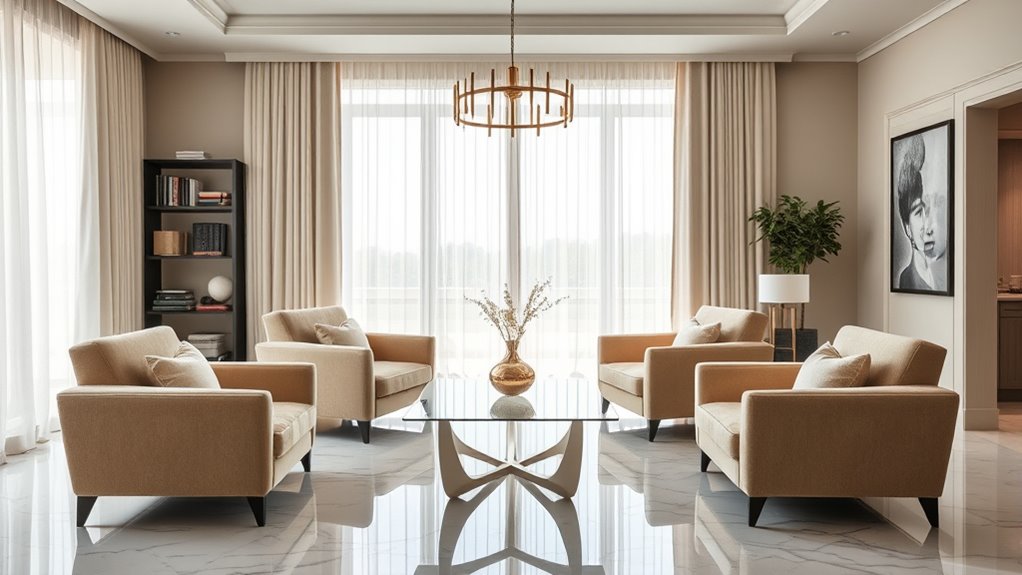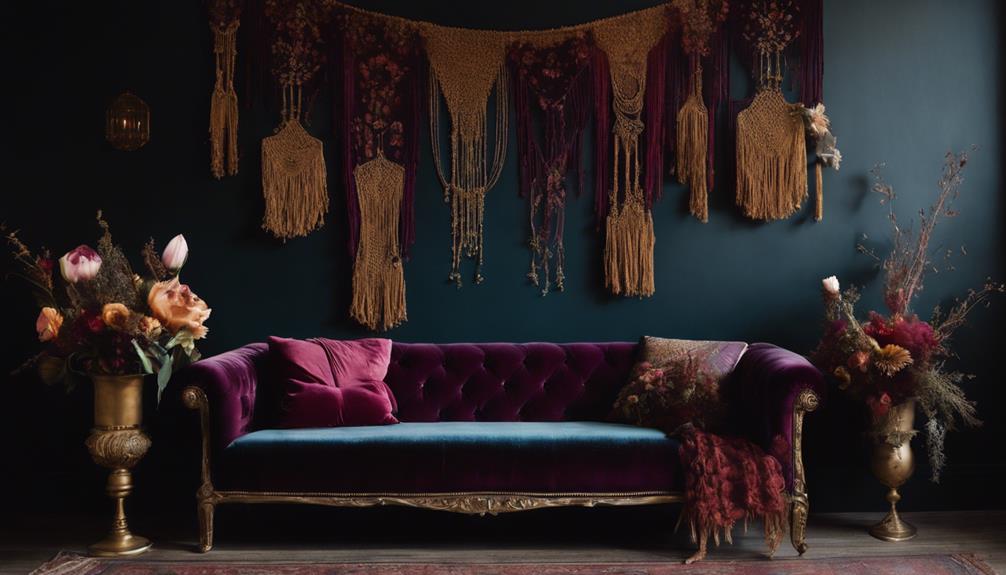Understanding the fundamentals of symmetry and asymmetry helps you create balanced or lively interior spaces. Symmetry offers harmony, stability, and a polished, classic look by mirroring elements and maintaining proportional balance. Asymmetry, on the other hand, introduces movement, creativity, and visual interest through bold contrasts and varied arrangements. Combining both styles allows you to craft dynamic environments that feel both cohesive and energetic. Keep exploring to discover how to master these powerful design principles in your space.
Key Takeaways
- Symmetry creates balance, harmony, and a formal, polished look by mirroring elements across a central axis.
- Asymmetry introduces visual interest and dynamism through varied sizes, colors, and textures, making spaces feel lively.
- Symmetrical designs evoke stability and tradition, ideal for formal or upscale interiors.
- Asymmetrical arrangements foster creativity and uniqueness, suitable for modern or eclectic decor styles.
- Combining both techniques can achieve a balanced yet engaging interior that emphasizes structure and visual interest.
Understanding Symmetry in Interior Design
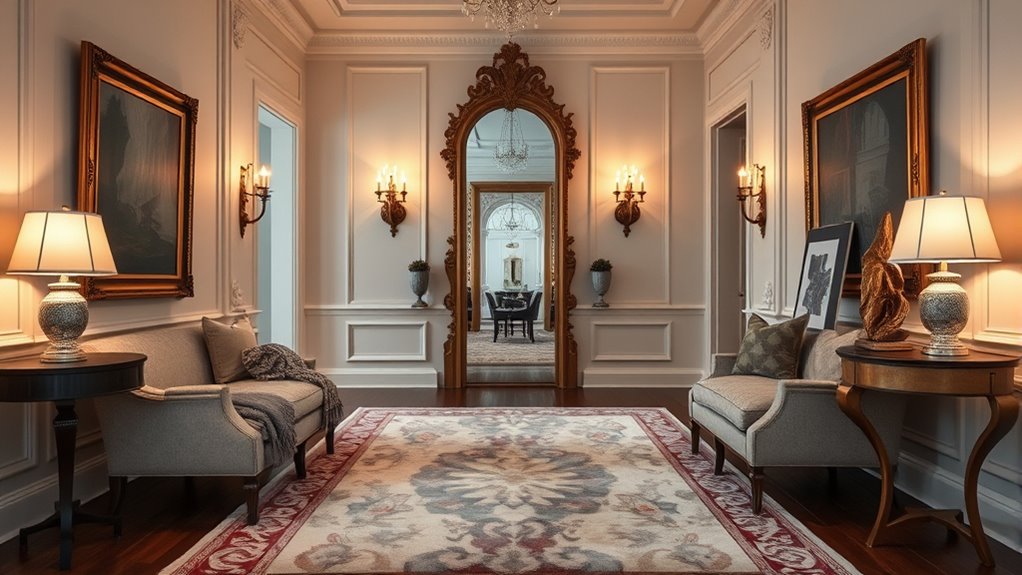
Symmetry in interior design creates a sense of balance and harmony that can make a space feel organized and welcoming. When you focus on proportional harmony, you ensure that elements are evenly distributed, reinforcing a cohesive look. Geometric precision plays a key role, as carefully aligned shapes and lines help establish symmetry. By mirroring furniture, artwork, or architectural features on either side of a central point, you create a visual flow that feels natural and calming. Symmetrical arrangements evoke stability and order, making your space appear thoughtfully designed. Incorporating high contrast ratios can further enhance the visual impact of symmetrical layouts by emphasizing depth and clarity. This approach is especially effective in formal areas like living rooms or foyers. When executed correctly, symmetry enhances the overall aesthetic, giving your interior a polished, unified appearance.
Exploring Asymmetry and Its Creative Potential
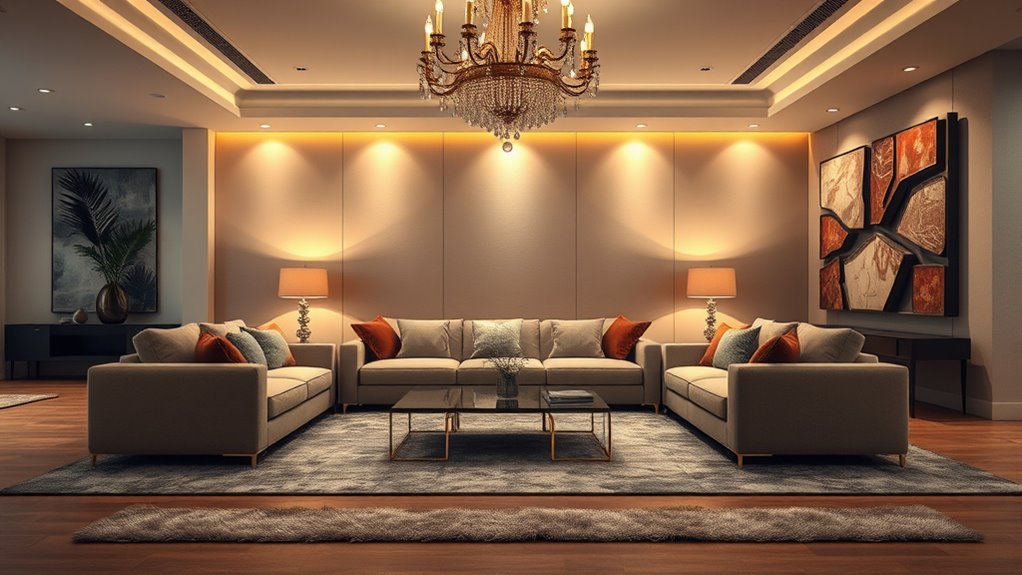
While symmetry emphasizes order, exploring asymmetry opens up a world of creative possibilities that can make your space feel dynamic and unique. You can play with bold color contrast and texture variation to create visual interest. Asymmetry allows you to break free from rigid patterns, giving your decor an energetic vibe. For example, balance a large, textured art piece on one side with smaller, contrasting decor on the other. Use varied materials and colors to add depth, making your space lively and inviting. Here’s a quick guide:
| Asymmetry Tips | Creative Effects |
|---|---|
| Use bold color contrast | Draws attention and creates focus |
| Incorporate texture variation | Adds depth and richness |
| Mix sizes and shapes | Creates visual interest |
| Place objects off-center | Enhances spontaneity |
Additionally, understanding visual interest can help you create more engaging interior designs that reflect your personal style.
Visual Balance: When to Use Symmetry
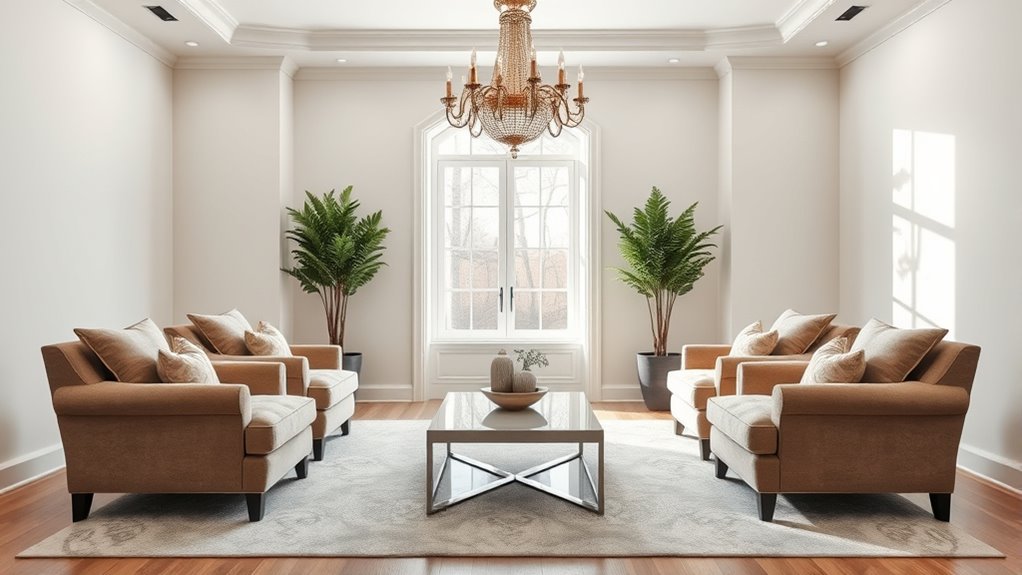
Symmetry creates a sense of formal elegance and order in your space, making it ideal for areas that need a polished look. When you want a harmonious focal point that draws the eye effortlessly, using symmetry helps achieve that balance. Consider symmetry when designing spaces that aim to feel refined, balanced, and visually cohesive. Additionally, incorporating vintage decor can further enhance the timeless quality of a symmetrically arranged room.
Formal Elegance
When aiming to create a sense of formal elegance, employing symmetry can be a powerful strategy. Symmetry introduces a sense of order and balance that exudes formal grace, perfect for refined decor. By mirroring elements—like matching tables, balanced artwork, or identical lighting—you establish a cohesive, sophisticated atmosphere. This approach emphasizes structure and tradition, making spaces feel polished and stately. Use symmetry when your goal is to evoke a timeless, upscale vibe that commands respect and admiration. It works particularly well in formal living rooms, dining areas, or home offices. Keep in mind that symmetry doesn’t mean everything must be perfectly identical; rather, it involves thoughtful balance and proportion that align with your overall design aesthetic. Additionally, understanding interior decor principles can help you refine your use of symmetry to create harmonious spaces.
Harmonious Focal Point
A harmonious focal point is most effective when you want to create visual balance that draws attention without overwhelming the space. To achieve this, consider color coordination—using complementary or muted hues that unify the area. Texture contrast also plays a key role; combining smooth surfaces with textured elements adds depth and interest while maintaining balance. When selecting a focal point, such as a fireplace or art piece, ensure it stands out through strategic color choices and varied textures, guiding the eye naturally. Avoid clutter or overly bold colors that disrupt harmony. Instead, aim for a cohesive look where the focal point enhances the room’s overall symmetry, creating a calm yet engaging environment that feels thoughtfully curated. Incorporating visual balance: when to use symmetry helps in establishing a harmonious interior design that appeals to the senses and creates a welcoming atmosphere.
Crafting Dynamic Spaces With Asymmetry

To create a lively and engaging space, embracing asymmetry allows you to break free from rigid patterns and introduce visual interest. Use color psychology to evoke emotions and add depth, balancing bold hues with softer shades for contrast. Material contrast also plays a crucial role—pairing rough with smooth surfaces or matte with glossy finishes creates visual tension that energizes a room. Asymmetry encourages you to experiment with placement, scale, and balance, making your space feel dynamic and unique. Instead of perfect symmetry, focus on creating interesting focal points that draw the eye naturally. This approach keeps your decor fresh and spontaneous, fostering a sense of movement and personality. Understanding the diversification benefits of asymmetric design helps in creating a more vibrant and adaptable environment. Ultimately, asymmetry access your creativity and transforms ordinary spaces into stimulating environments.
Combining Symmetry and Asymmetry for Impact
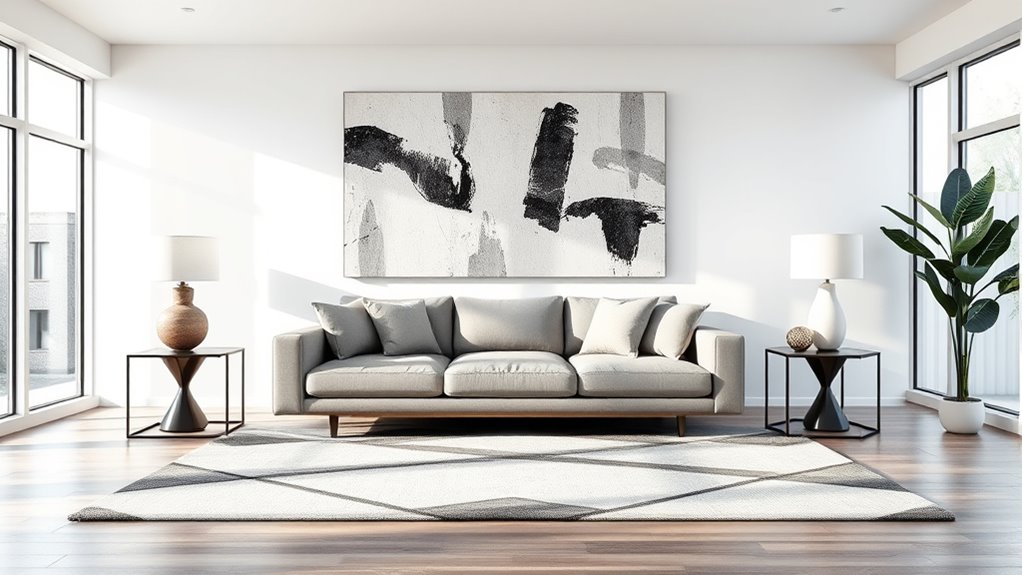
Mixing symmetry and asymmetry creates a space that feels both balanced and lively. You can achieve visual harmony while adding dynamic interest that keeps the eye engaged. Finding the right blend enhances your decor’s impact without overwhelming the senses. Incorporating beneficial ingredients like collagen and hyaluronic acid into design elements can subtly reinforce the overall aesthetic.
Balancing Visual Harmony
Balancing visual harmony involves thoughtfully combining symmetry and asymmetry to create spaces that are both engaging and cohesive. Start by choosing complementary color schemes that unify different elements, ensuring neither dominates the other. Use material textures to add depth—smooth surfaces paired with rougher finishes can create visual interest without disrupting harmony. Symmetrical arrangements provide stability, while asymmetrical accents introduce surprise, so blend them carefully. For example, balance a centered sofa with asymmetrical artwork or lighting. This mix guides the eye naturally across the space, avoiding monotony. Additionally, space optimization techniques can help ensure that both symmetrical and asymmetrical elements function together seamlessly, enhancing overall design fluidity. Ultimately, your goal is to craft a room that feels both balanced and dynamic, where color and texture work together to enhance the overall impact without overpowering each other.
Creating Dynamic Interest
Creating dynamic interest in interior decor involves thoughtfully combining symmetry and asymmetry to captivate attention and add visual excitement. You can achieve this by using striking color contrasts that draw the eye and create focal points. Incorporate diverse material textures—smooth, rough, glossy, matte—to introduce tactile variety and depth. For instance, pair sleek metal accents with soft textiles or rough wood with polished surfaces to balance visual weight and interest. Asymmetrical arrangements of furniture or art can break monotony, while symmetrical elements maintain harmony. When you blend these techniques, the space feels lively yet cohesive, inviting exploration. The key is to experiment with contrasts and unexpected pairings, making your interior vibrant and engaging without overwhelming the senses. Using material textures effectively can enhance the tactile and visual appeal of a space.
Practical Tips for Incorporating Both Styles
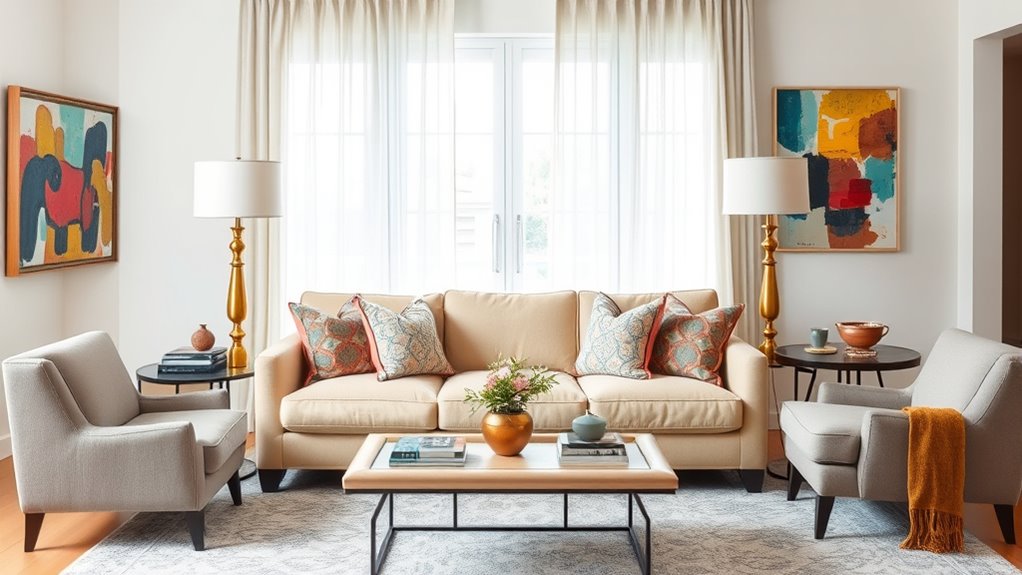
To successfully incorporate both symmetry and asymmetry into your interior design, start by identifying key elements that can serve as focal points. Focus on color coordination to balance bold and neutral tones, creating harmony between styles. Use texture contrast to add depth; pairing smooth surfaces with rough textures enhances visual interest. Here are practical tips:
Balance bold and neutral tones with texture contrast to create harmony and visual interest.
- Select a central piece with symmetrical placement to establish balance.
- Introduce asymmetrical accessories like artwork or vases for visual surprise.
- Mix patterns and textures to keep the space engaging.
- Use contrasting colors strategically, pairing calm shades with vibrant accents to emphasize focal points.
- Incorporate visual balance principles to maintain cohesion while celebrating contrast.
Frequently Asked Questions
How Do Cultural Differences Influence Preferences for Symmetry or Asymmetry?
Cultural differences greatly influence your aesthetic preferences, especially regarding symmetry and asymmetry. In some cultures, like Chinese or Japanese, cultural symbolism values harmony and balance, making symmetry more appealing. Conversely, Western cultures often favor asymmetry for its dynamic and unique appeal. Your cultural background shapes how you perceive beauty and balance, guiding your choices in interior decor to reflect cultural symbolism and personal aesthetic preferences.
Can Symmetry or Asymmetry Affect the Perceived Size of a Room?
Sure, symmetry can make your room feel spacious or cozy, depending on its proportions, while asymmetry might create a quirky vibe or claustrophobia. You see, it’s all about visual balance—symmetry tends to expand space, making rooms appear larger, whereas asymmetry can shrink or stretch perceptions. So, choose wisely; your room’s size might just depend on whether you crave harmony or chaos in your space proportions.
What Are Common Mistakes to Avoid When Mixing Both Styles?
When mixing symmetry and asymmetry, avoid disrupting the balance of focal points and visual harmony. Don’t overload one side or create clutter that distracts from the main features. Keep a cohesive color palette and make certain each element complements the others. Be mindful of scale and proportion, so your space feels intentionally balanced. This approach helps you blend styles seamlessly while maintaining a harmonious and inviting interior.
How Do Lighting Choices Impact the Effectiveness of Symmetrical or Asymmetrical Decor?
Your lighting choices play a vital role in highlighting the strengths of symmetrical or asymmetrical decor. You should aim for lighting balance to evenly illuminate focal points, drawing attention without overwhelming the design. For symmetry, use uniform lighting to emphasize balance and harmony. For asymmetry, experiment with varied lighting to create contrast and interest. Ultimately, your lighting shapes the mood, accentuates focal points, and enhances the overall effectiveness of your decor style.
Are There Specific Furniture Pieces Better Suited for Symmetry or Asymmetry?
You’ll find that furniture with clean lines and balanced focal points, like a symmetrical sofa or matching side tables, work well for creating a sense of harmony. For asymmetry, choose pieces with contrasting textures or irregular shapes, such as an eclectic armchair or a unique coffee table. These elements add visual interest and depth, helping you craft a dynamic space that balances visual weight through contrasting textures and focal points.
Conclusion
Now that you understand the fundamentals of symmetry and asymmetry, it’s time to decide how to shape your space. Will you embrace the timeless harmony of symmetry, or daringly break the rules with asymmetry? Or perhaps, you’ll blend both for a truly mesmerizing ambiance. The choice is yours, and the possibilities are endless. But remember, the most striking interiors often come from a clever balance—are you ready to discover what your unique style can become?

